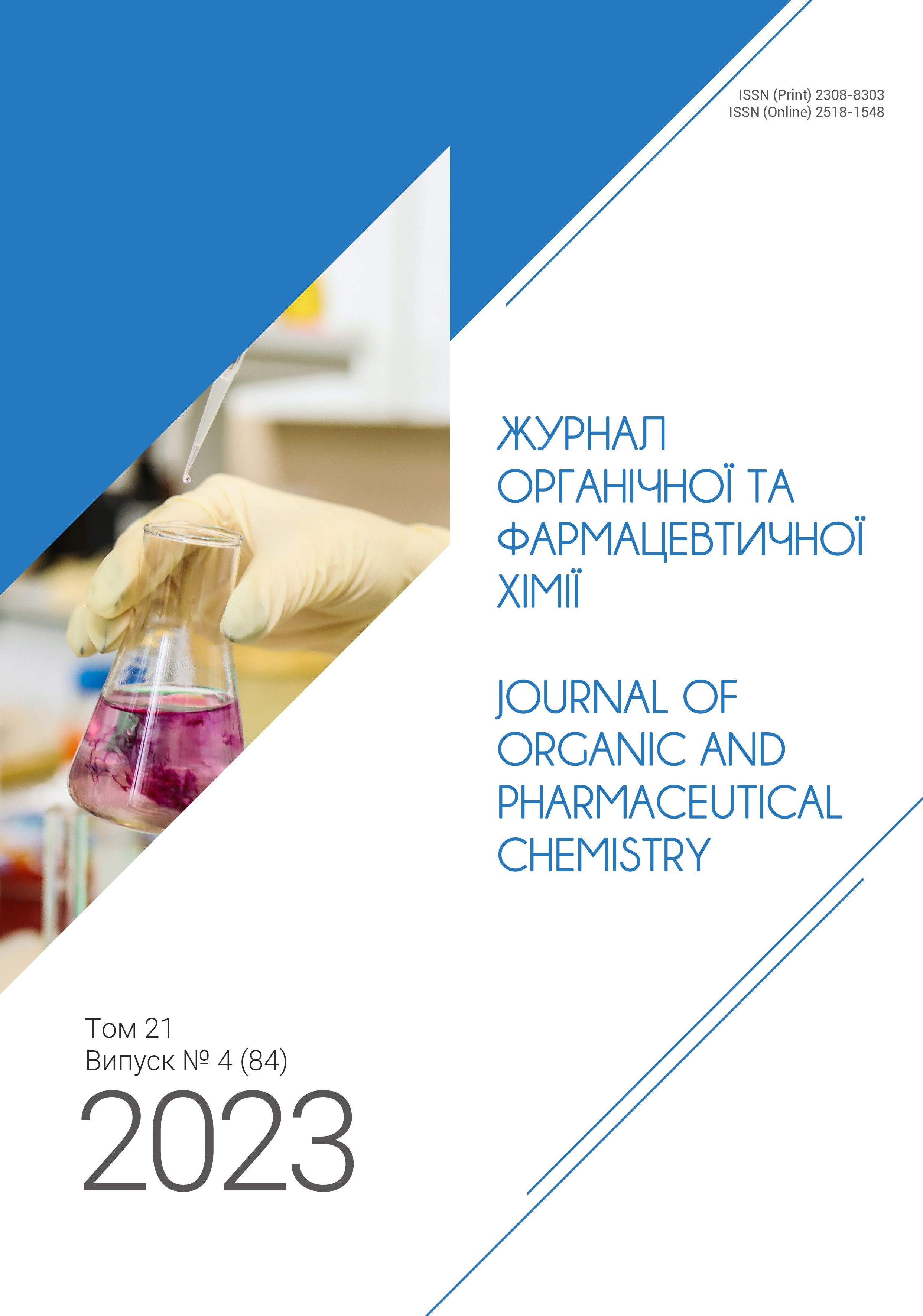An Efficient Synthesis of PARP Inhibitors Containing a 4-Trifluoromethyl Substituted 3,6,7,7a-Tetrahydro- 1H-pyrrolo[3,4-d]pyrimidine-2,5-dione Scaffold
DOI:
https://doi.org/10.24959/ophcj.23.298727Keywords:
Curtius rearrangement, heterocyclization, trifluoromethyl group, pyrrolo[3,4-d]pyrimidines, poly(ADP-ribose) polymerase inhibitorsAbstract
Poly(ADP-ribose) polymerases (PARPs) are key enzymes in the DNA repair pathway. Inhibitors of these enzymes belong to a new type of anticancer drugs that selectively kill cancer cells by targeting the homologous recombination genetic defects. This study presents a new synthetic approach to PARP inhibitors containing a 4-trifluoromethyl substituted 3,6,7,7a-tetrahydro-1H-pyrrolo[3,4-d]pyrimidine-2,5-dione scaffold. The method is based on a practical one-step cyclocondensation of 2-(2-oxo-1,2,3,4-tetrahydropyrimidin-4-yl)acetic acid derivatives via the Curtius rearrangement of the corresponding acyl azides formed in situ upon the treatment with diphenylphosphoryl azide. The resulting products have been found to possess a potent inhibitory effect on PARP-1 and PARP-2 isoforms of poly(ADP-ribose) polymerases. The structure–activity analysis has revealed that the N1-aryl substituent is crucial to the selectivity and high potency towards PARP-2, and that the p-fluorobenzyl group is the optimal group for the non-selective and potent PARP-1 and PARP-2 inhibition.
Supporting Agency
- The authors received no specific funding for this work.
Downloads
References
- Bai, P. Biology of Poly(ADP-Ribose) Polymerases: The Factotums of Cell Maintenance. Mol. Cell 2015, 58 (6), 947 - 958. https://doi.org/10.1016/j.molcel.2015.01.034.
 |
| 
- Mégnin-Chanet, F.; Bollet, M. A.; Hall, J. Targeting Poly(ADP-Ribose) Polymerase Activity for Cancer Therapy. Cell. Mol. Life Sci. 2010, 67 (21), 3649 - 3662. https://doi.org/10.1007/s00018-010-0490-8.
 |
| 
- Wang, Y.-Q.; Wang, P.-Y.; Wang, Y.-T.; Yang, G.-F.; Zhang, A.; Miao, Z.-H. An Update on Poly(ADP-Ribose)Polymerase-1 (PARP-1) Inhibitors: Opportunities and Challenges in Cancer Therapy. J. Med. Chem. 2016, 59 (21), 9575 - 9598. https://doi.org/10.1021/acs.jmedchem.6b00055.
 |
| 
- Lord, C. J.; Ashworth, A. PARP Inhibitors: Synthetic Lethality in the Clinic. Science 2017, 355 (6330), 1152 - 1158. https://doi.org/10.1126/science.aam7344.
 |
| 
- Steffen, J. D.; Brody, J. R.; Armen, R. S.; Pascal, J. M. Structural Implications for Selective Targeting of PARPs. Front. Oncol. 2013, 3. https://doi.org/10.3389/fonc.2013.00301.
 |
| 
- Zuo, X.; Zhao, H.; Li, D. Systematic Inhibitor Selectivity between PARP1 and PARP2 Enzymes: Molecular Implications for Ovarian Cancer Personalized Therapy. J. Mol. Recognit. 2021, 34 (7), 1 - 9. https://doi.org/10.1002/jmr.2891.
 |
| 
- Papeo, G.; Posteri, H.; Borghi, D.; Busel, A. A.; Caprera, F.; Casale, E.; Ciomei, M.; Cirla, A.; Corti, E.; D’Anello, M.; Fasolini, M.; Forte, B.; Galvani, A.; Isacchi, A.; Khvat, A.; Krasavin, M. Y.; Lupi, R.; Orsini, P.; Perego, R.; Pesenti, E.; Pezzetta, D.; Rainoldi, S.; Riccardi-Sirtori, F.; Scolaro, A.; Sola, F.; Zuccotto, F.; Felder, E. R.; Donati, D.; Montagnoli, A. Discovery of 2-[1-(4,4-Difluorocyclohexyl)Piperidin-4-yl]-6-Fluoro-3-Oxo-2,3-Dihydro-1H-Isoindole-4-Carboxamide (NMS-P118): A Potent, Orally Available, and Highly Selective PARP-1 Inhibitor for Cancer Therapy. J. Med. Chem. 2015, 58 (17), 6875 - 6898. https://doi.org/10.1021/acs.jmedchem.5b00680.
 |
| 
- Zhao, H.; Ji, M.; Cui, G.; Zhou, J.; Lai, F.; Chen, X.; Xu, B. Discovery of Novel Quinazoline-2,4(1H,3H)-Dione Derivatives as Potent PARP-2 Selective Inhibitors. Bioorg. Med. Chem. 2017, 25 (15), 4045 - 4054. https://doi.org/10.1016/j.bmc.2017.05.052.
 |
| 
- Lukianov, O.; Tkachuk, V.; Shishkina, S.; Lachmann, L.; Vadzyuk, O.; Borysko, P.; Kovalskyy, D.; Gillaizeau, I.; Sukach, V. Hydroaminoalkyl Functionalization of Pyrimidin‐2(1H)‐ones by Visible Light Organophotocatalysis: A Radical Approach to Biginelli‐Type Dihydropyrimidines. Adv. Synth. Catal. 2023, 365 (20), 3484 - 3492. https://doi.org/10.1002/adsc.202300781.

- Tkachuk, V. M.; Sukach, V. A.; Kovalchuk, K. V.; Vovk, M. V.; Nenajdenko, V. G. Development of an Efficient Route to CF3-Substituted Pyrrolopyrimidines through Understanding the Competition between Michael and Aza-Henry Reactions. Org. Biomol. Chem. 2015, 13 (5), 1420 - 1428. https://doi.org/10.1039/C4OB02233E.
 |
| 
- Melnykov, S. V; Pataman, A. S.; Dmytriv, Y. V; Shishkina, S. V; Vovk, M. V; Sukach, V. A. Regioselective Decarboxylative Addition of Malonic Acid and Its Mono(Thio)Esters to 4-Trifluoromethylpyrimidin-2(1H)-Ones. Beilstein J. Org. Chem. 2017, 13, 2617 - 2625. https://doi.org/10.3762/bjoc.13.259.
 |
| 
Downloads
Published
How to Cite
Issue
Section
License
Copyright (c) 2024 National University of Pharmacy

This work is licensed under a Creative Commons Attribution 4.0 International License.
Authors publishing their works in the Journal of Organic and Pharmaceutical Chemistry agree with the following terms:
1. Authors retain copyright and grant the journal the right of the first publication of the work under Creative Commons Attribution License allowing everyone to distribute and re-use the published material if proper citation of the original publication is given.
2. Authors are able to enter into separate, additional contractual arrangements for the non-exclusive distribution of the journal’s published version of the work (e.g., post it to an institutional repository or publish it in a book) providing proper citation of the original publication.
3. Authors are permitted and encouraged to post their work online (e.g. in institutional repositories or on authors’ personal websites) prior to and during the submission process, as it can lead to productive exchanges, as well as earlier and greater citation of published work (see The Effect of Open Access).















